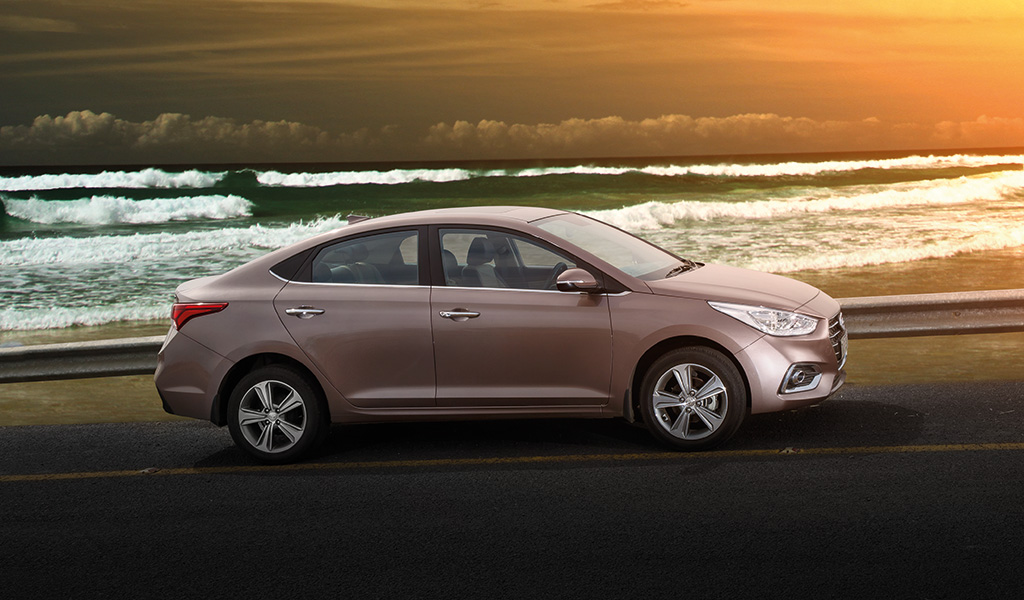The ICOTY 2018 winning Hyundai Verna sets new benchmarks

The essence of the Hyundai Verna
The essence of Hyundai, right from the start, has been to either create a segment where none exists or set the benchmark in the segment the brand operates in. Indian consumers, and critics, got the first taste of this when the company launched the very first Accent so many years ago. At the time, there was nothing in its segment that could go head to head with the Accent in a fair fight and come out on top. Hyundai was also the harbinger of sporty design to India with the advent of the Accent Viva, arguably India’s first ever notchback design. Subsequently, the Accent evolved into the Hyundai Verna and the Verna has continued to evolve since. Which, brings us to the current Verna.
The new generation of the Hyundai Verna sets the benchmark in design and engineering with its bold and dynamic lines and aggressive yet dignified road presence. Aspects that are echoed on the inside as well. As far as comfort features, technology and safety go, the Hyundai Verna is right up there with the best that the class has to offer. But a car is a lot more than just good – no, great – design and techno goodies. The soul of a car is also its heart, in this case the engine, and going by the engine line up for the new Hyundai Verna it can only be one delightfully soulful car to drive.
Speaking of engines, Hyundai again sets the benchmark in this segment of vehicles. Not only does it offer the two most powerful engine options but also the widest array of transmission choices to the customer. Depending on the trim level you choose, the Hyundai Verna is the only car in its segment to be sold with manual or automatic transmission across both engine options. Again, a benchmark for the segment, in effect, the essence of Hyundai and the essence of the Verna.
Performance with economy
First up, we have the 1.6L Gamma. This 1591cc four-cylinder petrol engine with DOHC and 4 valves/cylinder puts out 121bhp and 151Nm of torque. The petrol variant of the Verna is available with both a 6-speed manual gearbox or a 6-speed auto. It’s quite the joy to drive and feels punchy and brings the car alive with its responsiveness.
While the first option we have mentioned is the one for the petrolhead or those whose daily run wouldn’t warrant a diesel engine, the workhorse of the Verna fleet is undoubtedly the 1.6L CRDi VGT. The 1582cc four-cylinder turbocharged, CRDI unit is the largest and most powerful diesel engine money can buy in this segment. Peak output from this oil burner is 126bhp and 260Nm, all of which is channelled via either a slick shifting 6-speed manual gearbox or a 6-speed automatic. The beauty of this engine however lies beyond those obvious numbers. It lies in the shape of the engine’s torque curve, for in this case the peak torque kicks in at a very low 1500rpm and then stays with you all the way through to 3000rpm. What this means is that you can drive the Verna diesel with ease in every driving condition you can find yourself in, in India. Crowded city roads? Potter along without complaint. Overtaking cars? Just dab on the throttle to see how you whizz past the competition. None of this is at the cost of extra fuel, thanks to an ARAI certified fuel economy of 24.75kmpl.
Handling without paying with ride
When Ouseph drove the fifth generation of the Hyundai Verna earlier this year, he came back super impressed with the way this new car handled turns and how balanced it felt throughout. The secret to this is the new Hyundai Verna’s all-new K2 platform with an all-new super body structure.This structure uses 50 per cent ultra-high strength steel in place of the 13 per cent that is usually found in similar sedans.
Combined with the hot stamping process that is used to create this super body structure, the Verna can boast of an outstandingly rigid monocoque. This not only results in superior impact protection and NVH characteristics but also lends itself to excellent handling characteristics. Meanwhile the adoption of hydraulic rebound stoppers in the front suspension and use of vertical shock absorbers at the rear has improved ride quality and enhanced body control. The car’s caster and trail have been increased and the location of the steering gearbox has been optimised in an attempt to increase steering response and feedback.
All of these individual efforts of Hyundai’s engineers come together beautifully when you drive the car on a regular patch of road or want to enjoy The Thrill of Driving on a particularly twisty set of roads. There’s not much body roll and the vehicle responds beautifully as you throw it from one corner to the next. It doesn’t matter if you’re turning on the same side or if you’re changing directions, the car remains predictable and confidence inspiring at all times. The fact that this doesn’t come at the cost of good ride quality is critical to the Verna’s success as an all rounded package.


